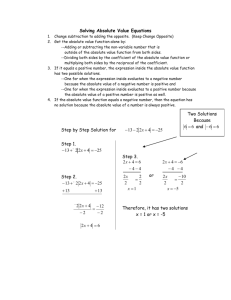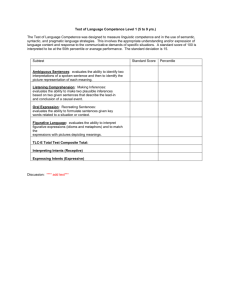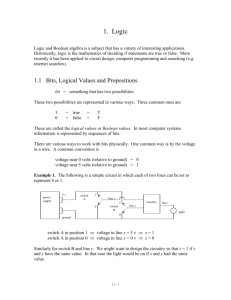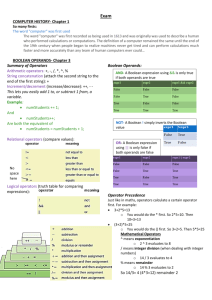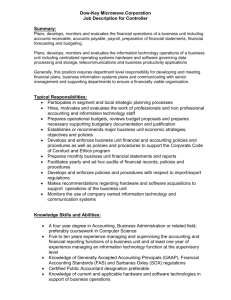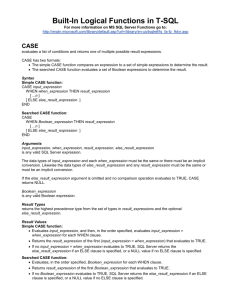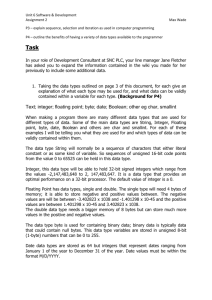C Programs: Boolean Expressions, Conditional Statements Boolean
advertisement
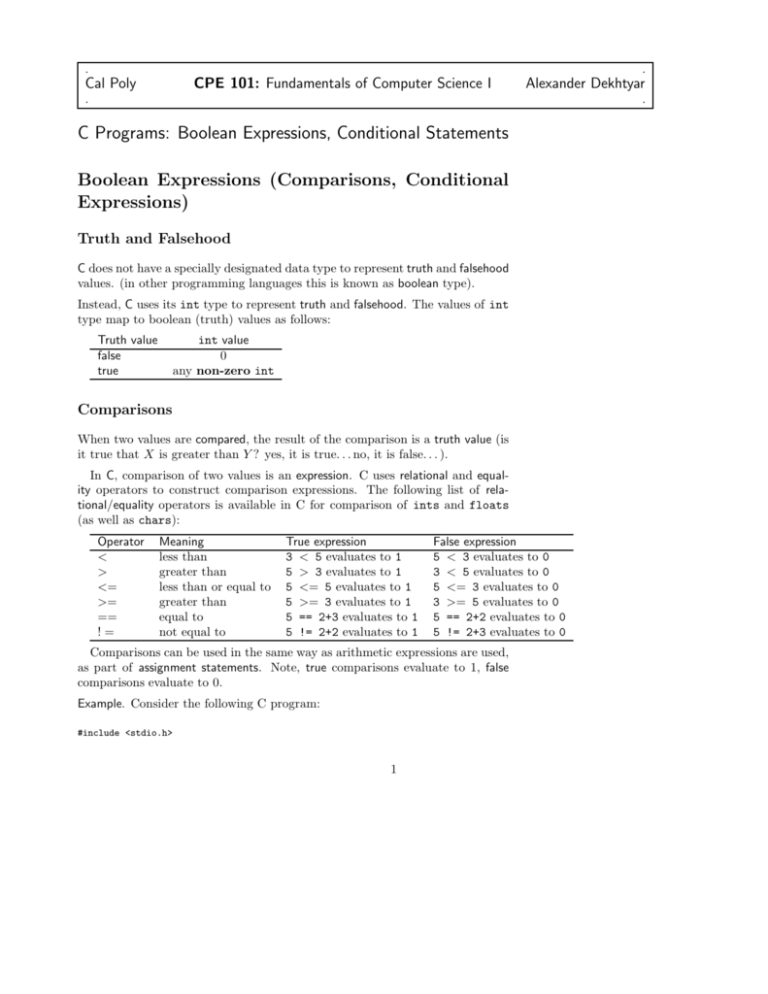
.
.
CPE 101: Fundamentals of Computer Science I
Cal Poly
Alexander Dekhtyar
.
.
C Programs: Boolean Expressions, Conditional Statements
Boolean Expressions (Comparisons, Conditional
Expressions)
Truth and Falsehood
C does not have a specially designated data type to represent truth and falsehood
values. (in other programming languages this is known as boolean type).
Instead, C uses its int type to represent truth and falsehood. The values of int
type map to boolean (truth) values as follows:
Truth value
false
true
int value
0
any non-zero int
Comparisons
When two values are compared, the result of the comparison is a truth value (is
it true that X is greater than Y ? yes, it is true. . . no, it is false. . . ).
In C, comparison of two values is an expression. C uses relational and equality operators to construct comparison expressions. The following list of relational/equality operators is available in C for comparison of ints and floats
(as well as chars):
Operator
<
>
<=
>=
==
!=
Meaning
less than
greater than
less than or equal to
greater than
equal to
not equal to
True expression
3 < 5 evaluates to 1
5 > 3 evaluates to 1
5 <= 5 evaluates to 1
5 >= 3 evaluates to 1
5 == 2+3 evaluates to 1
5 != 2+2 evaluates to 1
False expression
5 < 3 evaluates to 0
3 < 5 evaluates to 0
5 <= 3 evaluates to 0
3 >= 5 evaluates to 0
5 == 2+2 evaluates to 0
5 != 2+3 evaluates to 0
Comparisons can be used in the same way as arithmetic expressions are used,
as part of assignment statements. Note, true comparisons evaluate to 1, false
comparisons evaluate to 0.
Example. Consider the following C program:
#include <stdio.h>
1
int main() {
int x,y,b,c;
x = 10;
y = 5;
b = (x == y);
c = (x >= 2*y);
printf("%d\n%d\n%d\n",b,c,(b!=c));
return 0;
}
The output of the program is
0
1
1
Boolean (Logical) Operators
Often, one needs to obtain a truth value of a group of comparisons. This is done
using three boolean or logical operations: conjunction, disjunction and negation:
conjunction computes the truth value of all comparisons in the group evaluating to true.
disjunction computes the truth value of at least one comparison in the group
evaluating to true.
negation ”flips” the truth value of a comparison.
Logical Operator
conjunction
disjunction
negation
C operator
&&
||
!
Arity
binary
binary
unary
The syntax of a logical operation expression is:
<Expression> <Logical Operator> <Expression>
where <Logical Operator> is either && or ||, or
! <Expression>
(conventions about the standard use of partentheses apply)
Examples. The following are correct C logical expressions:
(2 == 1+1) && (3 == 4-1)
1 || 0
!(2 == 100 -90)
(! (3 == 2) && (1 || 0))
Meaning of boolean operators. The formal semantics of the boolean operators is described in the following tables:
Semantics of conjunction (&&)
<Expression1> <Expression2>
true (nonzero)
true (nonzero)
true (nonzero)
false (0)
false (0)
true (nonzero)
false (0)
false (0)
<Expression1> && <Expression2>
true (1)
false (0)
false (0)
false (0)
2
Semantics of disjunction (||)
<Expression1> <Expression2>
true (nonzero)
true (nonzero)
true (nonzero)
false (0)
false (0)
true (nonzero)
false (0)
false (0)
<Expression1> || <Expression2>
true (1)
true (1)
true (1)
false (0)
Semantics of negation (!)
<Expression> !<Expression>
true (nonzero)
false (0)
false (0)
true (1)
Operator precedence. The following is the operator precedence table for all
known to us C operators (arithmetic, assignment, comparison, logical):
Precedence Level
1. (highest)
2.
3.
4.
5.
6.
7.
8.
9. (lowest)
Operators
function calls
!, +, *, /, %
+,<, <=, >=, >
==, !=
&&
||
=
DeMorgan’s Theorem (Law).
Arity
varies
unary
binary
binary
binary
binary
binary
binary
binary
Behold the awesome power of logic!
!(<Expr1> && <Expr2>) is (!<Expr1> || !<Expr2>)
!(<Expr1> || <Expr2>) is (!<Expr1> && !<Expr2>)
If statement
Comparisons and logical operations allow us to construct expressions whose
values are interpreted as true and false (boolean expressions).
if statements (as well as switch statements to be discussed later) use boolean
expressions to determine which statements need to be executed next.
Up until now, in all programs we considered, all statements were executed
exactly in the order they appeared in the text of the program. Conditional C
statements (if statement and switch statement) diverge from this.
If statement with one alternative.
ment is
The syntax of the most simple if state-
if ( <expression>)
<statement-block>
Here, <expression> is any expression which evaluates to a truth value.
<statement-block> is either a single statement or a sequence of statements
enclosed in curly braces (”{”, ”}”).
Examples. A single-alternative if statement with a single statement inside it:
if (x <= 5)
y = x*x;
A simple single-alternative if statement with a statement block inside it:
3
if ( (x >= 5) && (x <= 20)) {
y = x*x;
x = x+1;
printf("%d\n", y);
}
Note: A closing curly brace ”}” is an indicator of the end of a group of
statements. As such, there is no need to follow it with a semicolumn.
Semantics. Single-alternative if statement is evaluated as follows:
1. <expression> is evaluated.
2. If <expression> evaluates to true (i.e., to a non-zero integer), then the
statement(s) from the <statement-block> is/are executed. After the
last statement in <statement-block> is executed (unless it was a return
statement), the statement immediately following the if statement will be
executed.
3. If <expression> evaluated to false (i.e., 0), the statement immediately
following the if statement will be executed.
If statement with two alternatives.
statement has the following syntax:
A more complex version of the if
if (<expression>)
<true-statement-block>
else
<false-statement-block>
Here, <expression> is any expression which evaluates to a truth value. <true-statement-block>
and <false-statement-block> are either single statements or sequences of
statements enclosed in curly braces (”{”, ”}”).
Examples. A two-alternative if statement with a single statements inside it:
if (x <= y)
printf("Max = %d\n",y);
else
printf("Max = %d\n",x);
A simple single-alternative if statement with a statement block inside it:
if ( (x >= 5) && (x <= 20)) {
y = x*x;
x = x+1;
printf("%d\n", y);
}
else {
y = (x-1)*(x-1);
x = x-1;
printf("%d\n",x);
}
Semantics. Two-alternative if statement is evaluated as follows:
1. <expression> is evaluated.
2. If <expression> evaluates to true (i.e., to a non-zero integer), then the
statement(s) from the <true-statement-block> is/are executed. After
the last statement in <false-statement-block> is executed (unless it
was a return statement), the statement immediately following the if
statement will be executed.
4
3. If <expression> evaluated to false (i.e., 0), then he statement(s) from
the <false-statement-block> is/are executed. After the last statement
in <false-statement-block> is executed (unless it was a return statement), the statement immediately following the if statement will be executed.
Example. In the first example above, if y is greater than or equal to x, the
if part of the statement will be executed, and the value of y will be printed to
standard output. If y is not greater than or equal to x (i.e., if x is greater than
y), the value of x will be printed to standard output.
Nested If statements
if statements can be parts of blocks of statement blocks inside other if statements. For example, the if ( (x >= 5) && (x <= 20)) condition can be
rewritten in a form nested if statements:
begin{verbatim}
if (x >= 5) {
if (x <= 20) {
y = x*x;
x = x+1;
printf("%d\n", y);
}
}
Note: please note the indentation of the if statements. It is extremely
important to keep proper track of the open and closed curly braces in your if
statements, especially, if you are using nested ifs.
5
